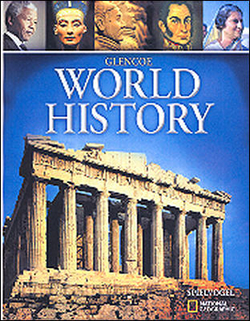Glencoe World History © 2010Chapter 16:
The East Asian WorldChapter OverviewsThe Ming emperors restored China to greatness. They were succeeded by the Qing dynasty, which ruled until 1911. Japanese unification began in the sixteenth century. Although Korea attempted to remain isolated, it fell under Chinese rule. Europeans struggled to control the profitable spice trade in Southeast Asia. Section 1 China at Its Height
The Mongol dynasty in China was overthrown in 1368 and replaced by the Ming dynasty. Ming emperors extended Chinese rule into Mongolia and central Asia and briefly reconquered Vietnam. They ran an effective centralized bureaucracy and made improvements that restored Chinese greatness. During the fifteenth century, Zheng He led seven voyages of exploration and traveled as far as East Africa. The arrival of a Portuguese fleet during the early sixteenth century led to an exchange of ideas and introduced Christian missionaries to China. The declining Ming dynasty was replaced by invading Manchus, who formed the Qing dynasty. The Qing lasted until 1911 and produced perhaps China's greatest emperor, Kangxi, who ruled for 61 years. By the late 1700s, the Qing were restricting European trade and contact. Section 2 Chinese Society and Culture
Improvements in agriculture during the Ming dynasty led to an increase in population. A growing shortage of land led to rural unrest. Manufacturing and trade increased steadily, but were tightly controlled by the government. Commercial capitalism—private business based on profit—did not emerge as it did in Europe. Daily life in China had changed little and remained focused around the family. Women could play strong family roles but were considered inferior to men. They received no formal education and could not seek a divorce or inherit property. The novel appeared as a new literary form during the Ming dynasty. During the Ming and Qing dynasties, an outpouring of artistic brilliance included stunning architecture, world-famous porcelain, and other decorative arts. Section 3 Tokugawa Japan and Korea
Japanese unification began in the mid-sixteenth century with three powerful political figures who reined in Japan's nobility. Tokugawa shoguns ushered in the "Great Peace" and ruled until 1868. Under Tokugawa rule, trade and manufacturing flourished as never before. Edo became a city of over a million people. Poetry, Kabuki dramas, architecture, and ceramics flourished. European traders and missionaries arrived, and many Japanese converted to Christianity. However, the missionaries' practice of destroying shrines led to their expulsion. All but a few European merchants were expelled as well. As the urban economy grew, many peasants were forced to become tenant farmers. Class distinctions became more rigid, and women as well as Japan's outcasts, the eta, faced greater restrictions. Korea, a country that tried to remain closed to the outside world, was twice invaded—once in a devastating Japanese invasion, and once by a Manchu army that made Korea subject to China. Section 4 Spice Trade in Southeast Asia
In 1500, mainland Southeast Asia was a relatively stable region. Occasional conflicts occurred between emerging kingdoms. Throughout Southeast Asia, foreign models of government were adapted to local circumstances. Buddhist kings ruled in Burma, Thailand, Laos, and Cambodia. The Javanese style of kingship was rooted in the political traditions of India. On the Malay Peninsula, the influence of Muslim traders led to the rise of the sultanate at Melaka. Islamic sultans also ruled in the small coastal states of Indonesia. In Vietnam, kingship followed the Chinese model and ruled according to Confucian teachings. In the Philippines, Christianity attracted converts. The rapid growth of the spice trade led Portugal to occupy the Moluccas, also known as the Spice Islands. The Dutch then pushed out the Portuguese and extended their control over the entire area. Europeans had less impact on mainland Southeast Asia, which had strong monarchies who were able to drive out most of the traders and missionaries.  | 
















